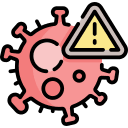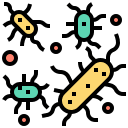
WHAT IS A VIRUSES & BACTERIA?
Let’s delve into the fascinating world of viruses and bacteria.

Virus
Definition
Viruses are tiny infectious agents that cannot survive or reproduce independently. They lack cellular structures and are composed of genetic material (either DNA or RNA) surrounded by a protein coat called a capsid.
Characteristics
a) Non-living: Viruses are not considered living organisms because they cannot carry out metabolic processes on their own.
b) Obligate parasites: They rely on host cells to replicate and multiply.
c) Specificity: Each virus has a specific host range (e.g., human, animal, plant) and targets specific cells.
d) Infectious: Viruses cause diseases by invading host cells and hijacking their machinery.
Examples
Influenza virus, HIV, SARS-CoV-2 (responsible for COVID-19)

Bacteria
Definition
Bacteria are single-celled microorganisms with a simple structure. They have a cell wall, cell membrane, cytoplasm, and genetic material (DNA).
Characteristics
a) Living organisms: Bacteria are considered living because they can carry out metabolic processes independently.
b) Diverse: Bacteria come in various shapes (e.g., cocci, bacilli, spirilla) and can thrive in different environments.
c) Beneficial and harmful: While some bacteria are essential for processes like digestion and nitrogen fixation, others cause diseases.
d) Reproduction: Bacteria reproduce through binary fission.
Examples
E. coli (found in the gut), Streptococcus (causes strep throat), Staphylococcus (can cause skin infections)

Indoor Contamination
Both viruses and bacteria can be present indoors.
Sources
They originate from human occupants, pets, and the outdoor environment.
Locations
They exist on surfaces, as suspended particles, or as bioaerosols in indoor air.

Health Risks

Some bacteria can cause infections, food poisoning, or skin conditions.

Viral particles can remain suspended in the air and pose a risk of transmission.

The pandemic has highlighted the importance of indoor air quality and hygiene.
Mitigation Strategies
Regular cleaning and disinfection
Proper ventilation
Professional disinfection services
Treatment and Disinfection Services
Professional Disinfection Services
a) These services use approved chemicals and methods to eliminate harmful microbes.
b) Authorized by KKM (Malaysia’s Ministry of Health) and certified Halal.
c) Effective against viruses like COVID-19.
d) Available for both residential and commercial spaces.
Methods
a) Disinfection Misting: Efficiently delivers virucides to surfaces.
b) Pressure Spraying: Directly applies disinfectant to targeted areas.
c) Surface Wiping: Uses high-level disinfectants to kill viruses on surfaces.
Summary
Maintaining a clean and hygienic indoor environment is crucial for our well-being. If you need professional disinfection services, consider reaching out to experts who follow safety guidelines and use effective methods.

Home » Viruses And Bacteria
Let’s delve into the fascinating world of viruses and bacteria.
Viruses:Definition: Viruses are tiny infectious agents that cannot survive or reproduce independently. They lack cellular structures and are composed of genetic material (either DNA or RNA) surrounded by a protein coat called a capsid.
Characteristics:
a) Non-living: Viruses are not considered living organisms because they cannot carry out metabolic processes on their own.
b) Obligate parasites: They rely on host cells to replicate and multiply.
c) Specificity: Each virus has a specific host range (e.g., human, animal, plant) and targets specific cells.
d) Infectious: Viruses cause diseases by invading host cells and hijacking their machinery.
Examples: Influenza virus, HIV, SARS-CoV-2 (responsible for COVID-19).
Bacteria:Definition: Bacteria are single-celled microorganisms with a simple structure. They have a cell wall, cell membrane, cytoplasm, and genetic material (DNA).
Characteristics:
a) Living organisms: Bacteria are considered living because they can carry out metabolic processes independently.
b) Diverse: Bacteria come in various shapes (e.g., cocci, bacilli, spirilla) and can thrive in different environments.
c) Beneficial and harmful: While some bacteria are essential for processes like digestion and nitrogen fixation, others cause diseases.
d) Reproduction: Bacteria reproduce through binary fission.
Examples: E. coli (found in the gut), Streptococcus (causes strep throat), Staphylococcus (can cause skin infections).
Indoor Contamination:Both viruses and bacteria can be present indoors:
a) Sources: They originate from human occupants, pets, and the outdoor environment.
b) Locations: They exist on surfaces, as suspended particles, or as bioaerosols in indoor air.
Health Risks:
a) Bacteria: Some bacteria can cause infections, food poisoning, or skin conditions.
b) Viruses: Viral particles can remain suspended in the air and pose a risk of transmission.
c) COVID-19: The pandemic has highlighted the importance of indoor air quality and hygiene.
Mitigation Strategies:
Remember, maintaining a clean and hygienic indoor environment is crucial for our well-being. If you need professional disinfection services, consider reaching out to experts who follow safety guidelines and use effective methods.

Don’t let termites ruin your home or business. Call us today to schedule an inspection and get a personalised treatment plan. With our help, your property stays safe and termite-free.
KLANG VALLEY (HQ)
Cheras
1 700 81 7529
NEGERI SEMBILAN
Seremban
+606 763 3929
MELAKA
Batu Berendam
+606 317 5939
JOHOR
Johor Bahru
+607 244 8558
PERAK
Ipoh
1 700 82 0529
PENANG &KEDAH
Perai / Alor Setar
+604 240 2037
© 2025 Skill Termite. All Rights Reserved.
Our team of experts is ready to help you eliminate pests quickly and safely. Get your free quote now!